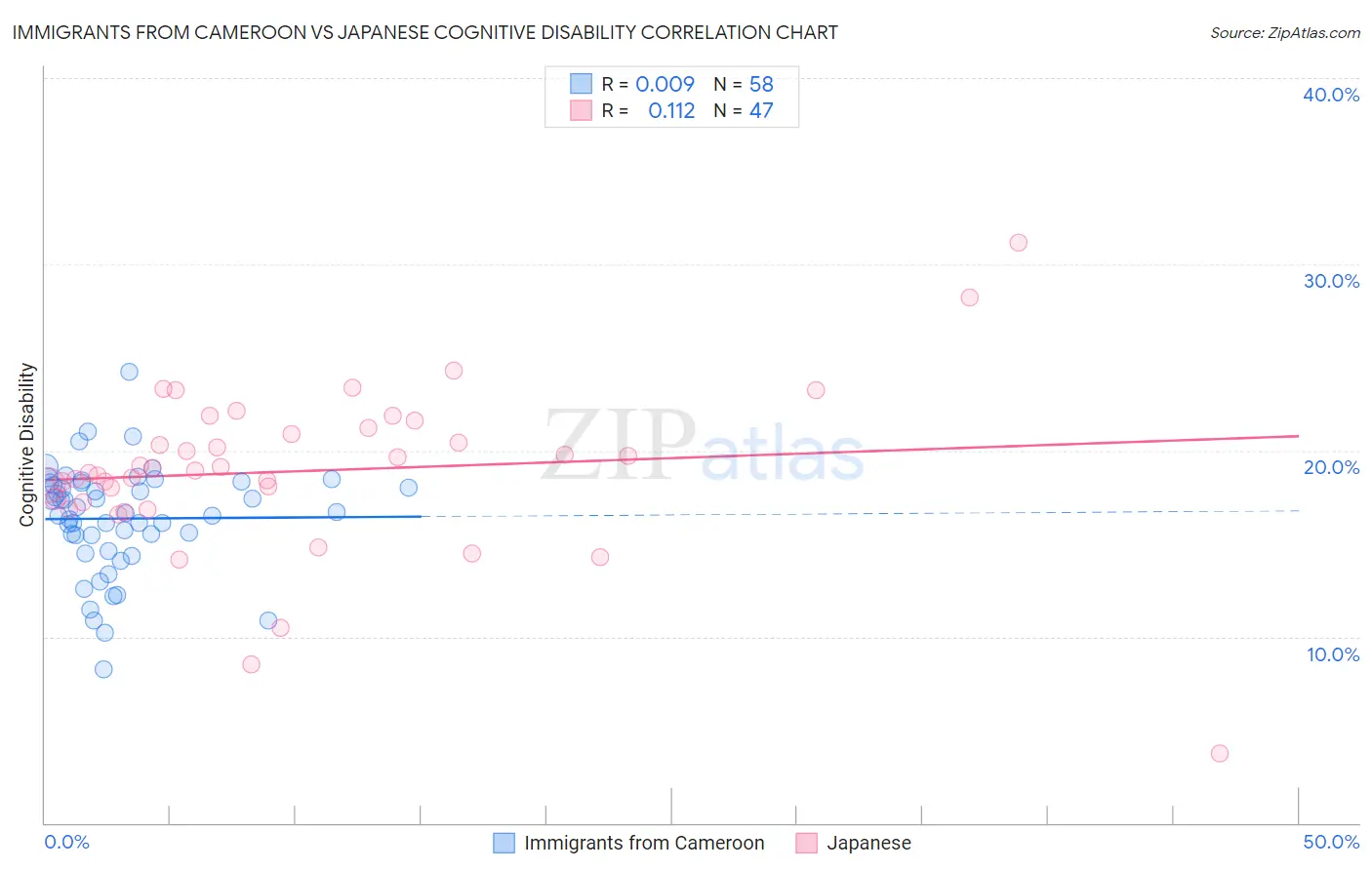Immigrants from Cameroon vs Japanese Cognitive Disability
COMPARE
Immigrants from Cameroon
Japanese
Cognitive Disability
Cognitive Disability Comparison
Immigrants from Cameroon
Japanese
17.6%
COGNITIVE DISABILITY
9.3/ 100
METRIC RATING
208th/ 347
METRIC RANK
18.3%
COGNITIVE DISABILITY
0.0/ 100
METRIC RATING
298th/ 347
METRIC RANK
Immigrants from Cameroon vs Japanese Cognitive Disability Correlation Chart
The statistical analysis conducted on geographies consisting of 130,751,694 people shows no correlation between the proportion of Immigrants from Cameroon and percentage of population with cognitive disability in the United States with a correlation coefficient (R) of 0.009 and weighted average of 17.6%. Similarly, the statistical analysis conducted on geographies consisting of 249,155,070 people shows a poor positive correlation between the proportion of Japanese and percentage of population with cognitive disability in the United States with a correlation coefficient (R) of 0.112 and weighted average of 18.3%, a difference of 4.0%.

Cognitive Disability Correlation Summary
| Measurement | Immigrants from Cameroon | Japanese |
| Minimum | 8.3% | 3.7% |
| Maximum | 24.2% | 31.2% |
| Range | 15.9% | 27.4% |
| Mean | 16.3% | 18.9% |
| Median | 16.7% | 18.9% |
| Interquartile 25% (IQ1) | 15.5% | 17.2% |
| Interquartile 75% (IQ3) | 18.3% | 21.2% |
| Interquartile Range (IQR) | 2.8% | 4.0% |
| Standard Deviation (Sample) | 2.9% | 4.5% |
| Standard Deviation (Population) | 2.9% | 4.4% |
Similar Demographics by Cognitive Disability
Demographics Similar to Immigrants from Cameroon by Cognitive Disability
In terms of cognitive disability, the demographic groups most similar to Immigrants from Cameroon are Immigrants from Latin America (17.6%, a difference of 0.030%), Immigrants from Trinidad and Tobago (17.6%, a difference of 0.050%), Immigrants from Jamaica (17.6%, a difference of 0.070%), Alaska Native (17.5%, a difference of 0.090%), and Puget Sound Salish (17.5%, a difference of 0.12%).
| Demographics | Rating | Rank | Cognitive Disability |
| South American Indians | 13.0 /100 | #201 | Poor 17.5% |
| Immigrants | Morocco | 12.0 /100 | #202 | Poor 17.5% |
| Immigrants | Caribbean | 11.0 /100 | #203 | Poor 17.5% |
| Immigrants | Zimbabwe | 11.0 /100 | #204 | Poor 17.5% |
| Puget Sound Salish | 10.9 /100 | #205 | Poor 17.5% |
| Alaska Natives | 10.4 /100 | #206 | Poor 17.5% |
| Immigrants | Latin America | 9.7 /100 | #207 | Tragic 17.6% |
| Immigrants | Cameroon | 9.3 /100 | #208 | Tragic 17.6% |
| Immigrants | Trinidad and Tobago | 8.7 /100 | #209 | Tragic 17.6% |
| Immigrants | Jamaica | 8.5 /100 | #210 | Tragic 17.6% |
| Taiwanese | 7.7 /100 | #211 | Tragic 17.6% |
| Immigrants | Oceania | 7.3 /100 | #212 | Tragic 17.6% |
| Hawaiians | 7.2 /100 | #213 | Tragic 17.6% |
| Immigrants | El Salvador | 7.0 /100 | #214 | Tragic 17.6% |
| Alaskan Athabascans | 6.9 /100 | #215 | Tragic 17.6% |
Demographics Similar to Japanese by Cognitive Disability
In terms of cognitive disability, the demographic groups most similar to Japanese are Blackfeet (18.3%, a difference of 0.0%), Ghanaian (18.3%, a difference of 0.030%), Creek (18.3%, a difference of 0.060%), Immigrants from Burma/Myanmar (18.2%, a difference of 0.14%), and German Russian (18.2%, a difference of 0.17%).
| Demographics | Rating | Rank | Cognitive Disability |
| Ottawa | 0.1 /100 | #291 | Tragic 18.2% |
| Iroquois | 0.1 /100 | #292 | Tragic 18.2% |
| Central American Indians | 0.1 /100 | #293 | Tragic 18.2% |
| British West Indians | 0.1 /100 | #294 | Tragic 18.2% |
| German Russians | 0.0 /100 | #295 | Tragic 18.2% |
| Immigrants | Burma/Myanmar | 0.0 /100 | #296 | Tragic 18.2% |
| Blackfeet | 0.0 /100 | #297 | Tragic 18.3% |
| Japanese | 0.0 /100 | #298 | Tragic 18.3% |
| Ghanaians | 0.0 /100 | #299 | Tragic 18.3% |
| Creek | 0.0 /100 | #300 | Tragic 18.3% |
| Immigrants | Ghana | 0.0 /100 | #301 | Tragic 18.3% |
| Barbadians | 0.0 /100 | #302 | Tragic 18.3% |
| Immigrants | Kenya | 0.0 /100 | #303 | Tragic 18.3% |
| Immigrants | Eritrea | 0.0 /100 | #304 | Tragic 18.3% |
| Colville | 0.0 /100 | #305 | Tragic 18.3% |